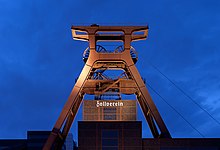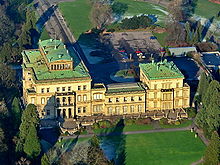Industrial Heritage Trail (German: Route der Industriekultur, also translated as "Route of industrial heritage") is a themed route in the Ruhr area in western Germany, and a prime example of industrial tourism.

Understand[edit]

Until the 1970s, the Ruhr was one of the most important zones of coal mining and heavy industry in Europe. Since then, many pits, cokeries and steel mills had to close down due to a declined demand and competition from low-wage countries. The economy, landscape and environment of the region has changed dramatically. Many industrial landmarks have been transformed into museums, exhibition halls, cultural institutions, event locations and recreational areas.
Prepare[edit]

The route has a total length of about 400 km. It encompasses important industrial sites, but also worker settlements, parks and panorama viewpoints. The vast majority of them are easy to reach by public transport, although even by car it'd be impossible to visit even a part of them in a single day.
The major sites are so-called Anchor points (Ankerpunkte), of which there are 25.
You should visit the official website or the Information Centre at Zeche Zollverein to get an idea of what you want to see and do on your trip.
Get in[edit]
The Ruhr area is well connected by public transport, both in itself, as well as to the rest of the country and region. The closest airports are in 1 Düsseldorf Airport and 2 Dortmund Airport, the latter primarily seeing budget flights, especially to eastern europe and the balkans.
ICE highspeed trains stop in Duisburg, Essen, Bochum, Dortmund and Hamm. Eurostar trains ending in Dortmund and Essen offer a quick connection to Belgium and Paris. Regional services offer a quick ride to Düsseldorf or across the dutch border.
Highways cover the entire region in a dense web, but traffic during rush-hour can be a slow crawl.
Go[edit]



There are 25 so-called anchor points on the route, as well as 26 themed sub-routes.
- 1 Essen.: Zeche Zollverein pit and cokery, UNESCO World Heritage site
- 2 Bochum.: Jahrhunderthalle and Deutsches Bergbau-Museum (German Museum of Mining)
- Recklinghausen: substation (housing the "Museum of Electricity and Life")
- Herten: Zeche Ewald
- Marl: chemical park
- Waltrop: Henrichenburg lift lock
- 3 Dortmund.: Zeche Zollern, DASA (exhibition on health and safety protection at the workplace) and Hansa cokery
- 4 Hamm.: Maximilianpark
- Unna: Lindenbrauerei brewery and centre of international light art
- 5 Hagen.: Hohenhof (former residence of Karl Ernst Osthaus) and open-air museum of handicraft and technology
- Witten: Zeche Nachtigall (pit and museum of industrial culture)
- Hatten: Henrichshütte (steel mill and museum of industrial culture)
- 6 Essen.: Villa Hügel (palace of the Krupp family of industrialists)
- 7 Mülheim an der Ruhr.: Aquarius water museum in a historical water tower
- 8 Duisburg.: inland harbour, museum of inland navigation Landschaftspark Duisburg-Nord (LaPaDu, former steel mills estate, now partly recultivated)
- 9 Oberhausen. Museum of Industry (former zink factory), Gasometer
- 10 Gelsenkirchen. Nordsternpark (former coal pit transformed into a horticultural exhibition area)
Stay safe[edit]
Go next[edit]
Similarly themed itinaries:
- Industrial Britain
- American Industry Tour, United States
- European Route of Industrial Heritage, an initiative sponsored by the Council of Europe

